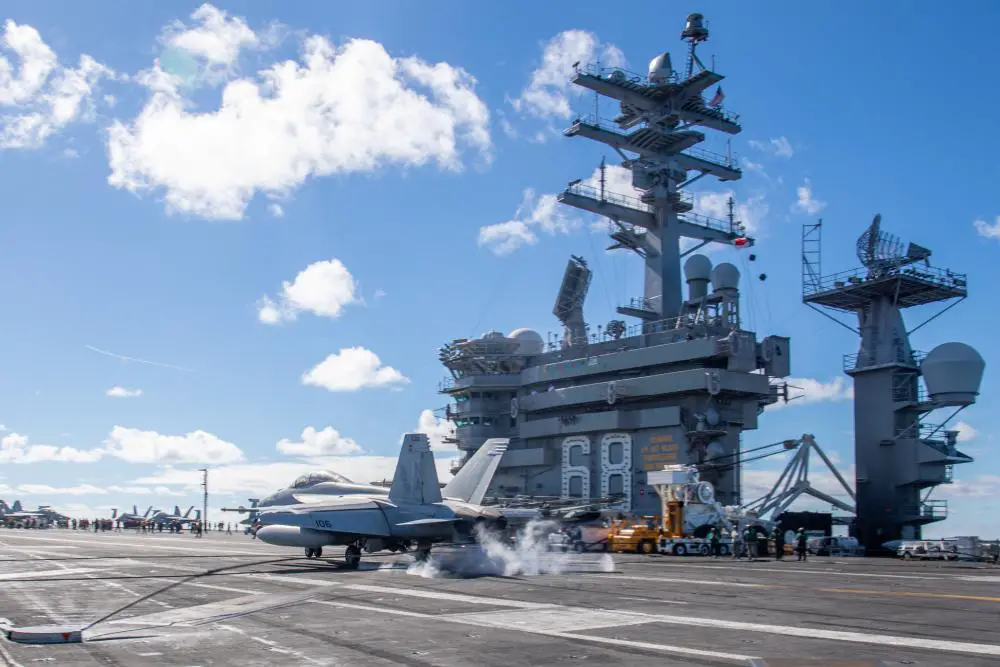Carrier Strike Group Eleven (CSG 11) returned to homeport Oct. 28, after completing Composite Training Unit Exercise (COMPTUEX), its final training period before a scheduled deployment later this year. The exercise was conducted by CSG 15, 3rd Fleet’s executive agent for integrated training, mentorship, and assessment of Pacific Fleet CSGs, Amphibious Ready Groups (ARG), Expeditionary Strike Groups (ESG), and independently deploying surface warships. With the completion of this exercise CSG 11 is ready for deployment. COMPTUEX is designed to fully integrate units of a CSG, while building its ability to carry out sustained combat operations at sea. Ships, squadrons and staffs trained across a spectrum of Sea Control and Power Projection missions.
“After a very busy year, we’ve reached our goal – to ready this aircraft carrier for deployment and sail west. I can assure you that this ship and crew is ready for whatever lies ahead of us,” said Capt. Craig Sicola, commanding officer, USS Nimitz.
“The strike group and the Officers, Chiefs and Sailors assigned to our ships and squadrons worked hard and have now seen it pay off. We’re a ready and capable strike group, looking forward to any challenge ahead of us, and prepared to effectively respond to any contingency,” said Rear Adm. Christopher Sweeney. Rear Adm. Christopher Sweeney, commander, CSG 11, has been in command since April 2021 and led his strike group through the entire work up, training, evaluation and certification period.

The aircraft carrier USS Nimitz (CVN 68) is CSG 11’s flagship – a mobile and lethal airfield equipped with command and control capabilities to support and operate aircraft from CVW 17. Carrier Air Wing (CVW) 17 is composed of embarked Strike Fighter (VFA) squadrons flying F/A-18E/F Super Hornets, an Electronic Attack (VAQ) squadron flying the E/A-18G Growler, a Carrier Airborne Early Warning (VAW) squadron flying the E-2C Hawkeye, a Fleet Logistic Squadron (VRC) flying the C-2A Greyhound, a Helicopter Maritime Strike (HSM) squadron flying the MH-60R Sea Hawk, and a Helicopter Sea Combat (HSC) squadron flying the MH-60S Sea Hawk. Information warfare combined warfighting elements such as meteorology, oceanography, intelligence, communications, cyber operations, electronic warfare and information operations to enable assured command and control, battlespace awareness, and non-kinetic effects.
Destroyer Squadron (DESRON) 9 oversaw operations for the Arleigh Burke-class guided-missile destroyers USS Decatur (DDG 73), USS Paul Hamilton (DDG 60), USS Chung-Hoon (DDG 93), USS Wayne E. Meyer (DDG 108), USS Shoup (DDG 86), and USS John Finn (DDG 113). Increasing combat potential across the maritime environment, DDGs are a multi-mission afloat platform with offensive and defensive capabilities, including anti-air warfare (AAW), anti-submarine warfare (ASW), anti-surface warfare (ASUW), and strike warfare (STK). The Ticonderoga-class guided-missile cruiser USS Bunker Hill (CG 52) is the Integrated Air and Missile Defense Commander. Bunker Hill is a multi-mission air warfare (AW), undersea warfare (USW), Naval surface fire support (NSFS), anti-surface warfare (SUW) and strike warfare (STK) warship capable of both offensive and defensive naval operations.












